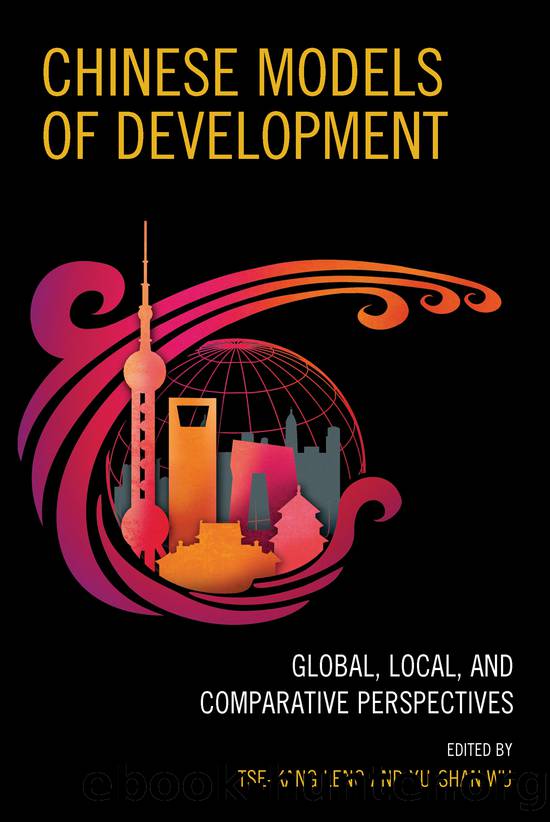Chinese Models of Development by unknow

Author:unknow
Language: eng
Format: epub
Publisher: Lexington Books/Fortress Academic
A Sino-Vietnamese Model
The remarkable economic success of China over the past thirty years has led Joshua Ramo to propose a âBeijing Consensusâ about development in opposition to the âWashington Consensus.â31 His formulation has been much criticized inside and outside of China, but it is certainly worthwhile to go beyond the narrative of Chinaâs development to more general questions of the mechanisms and their applicability elsewhere. Broadening the focus to include Vietnam as well as China should help transcend some of Chinaâs idiosyncrasies and specify background conditions for applicability.
Rural Roots and Popular Mobilization
The Sino-Vietnamese model can and should begin with rural revolution rather than with current reform. For most purposes this is a major limitation of the model, since the conditions for rural revolution have mostly passed from the world scene. But the continuing appeal of âMaoismâ to radical groups in Nepal and India indicates some relevance. The lesson of the Sino-Vietnamese experience for ongoing rural radicalism was best put by Mao Zedong:
If we only mobilize the people to carry on the war and do nothing else, can we succeed in defeating the enemy? Of course not. . ..We must. . .solve the problems facing the massesâfood, shelter, and clothing, fuel, rice, cooking oil, and salt, sickness and hygiene, and marriage. In short, all the practical problems in the massesâ everyday life should claim our attention. If we attend to these problems, solve them and satisfy the needs of the masses, we shall really become organizers of the well-being of the masses, and they will truly rally around us and give us their warm support. Comrades, will we then be able to arouse them to take part in the revolutionary war? Yes, indeed we will.32
The lesson of the key importance of mass-regarding policy could apply to any political mobilization from below challenging an unpopular regime or occupying power. Suicide bombers and roadside explosives may improve the technology of resistance, but any action that terrorizes and alienates the popular base cuts the root of protracted struggle. A final lesson of rural revolution is derived from the contrast between China and Vietnam and European Communism. Revolutions based on mobilizing the power of the people have profound consequences for post-revolutionary capabilities. A party-state built from the ground up is in a leadership situation fundamentally different from that of one that is constructed in post-revolutionary consolidation or imposition.
There are negative lessons from Chinaâs leftism and Vietnamâs socialist construction. The Great Leap Forward demonstrated that mass mobilization does not work as a modernization strategy even when it is carried out by a state with extraordinary mobilizational capacity. Indeed, if China had been less able to mobilize then the tragic consequences of its failure would have been reduced. The Great Proletarian Cultural Revolution provided the even deeper lesson that society requires respect for its complexity in order to operate. Chaosânot a better, egalitarian worldâis the alternative to complexity. The anti-modern utopian tendencies inherent in Marxism were buried by the Red Guards.
Vietnam did not provide the only negative lesson of socialist construction; the example of the Soviet Union is the overarching one.
Download
This site does not store any files on its server. We only index and link to content provided by other sites. Please contact the content providers to delete copyright contents if any and email us, we'll remove relevant links or contents immediately.
A Friend in the Dark by Pascal Ruter(179)
Different-Worlds-18 by Unknown(167)
The Art of SEO by Eric Enge Stephan Spencer and Jessie Stricchiola(167)
Digital Infrared Photography Photo Workshop by Sandidge Deborah(165)
Man-Machine-Environment System Engineering by Unknown(164)
The Pyramid Mind by Vlad Beliavsky(156)
Encyclopedia Of Mathematics (2005) by Unknown(143)
Brave by Wendy Constance(141)
The Three Rs and the Humanity Criterion by Michael Balls(131)
å¯åå °å²å¦æéï¼è±æ by 冯友兰(126)
Pirates, Prisoners, and Lepers: Lessons from Life Outside the Law by Paul H. Robinson & Sarah M. Robinson(121)
Command-Line by Unknown(115)
To Me, The One Who Loved You by Yomoji Otono(113)
SAYE by Wu Zhe(112)
Fairy Tales for the Disillusioned by Gretchen Schultz(109)
Different Worlds #12 by Unknown(108)
Randolph Caldecott--The Man Who Could Not Stop Drawing by Leonard S. Marcus(106)
ä¸å½å¤å ¸æå¦ç®å²ï¼è±æ by 冯沅君(105)
Computational Geometry by Unknown(105)
